37 Pilgrim’s Progress: A Spiritual Journey Along the Appalachian Trail
Will Babb
I’m Will. Prior to attending Ohio State, I thru hiked the Appalachian Trail, and the positive impacts of that experience stuck with me throughout college and formed the basis for this paper, written in my senior year for Religion and Environmental Values in America. I realized that my own experiences on the trail and the spiritual transformation I went through was not unique, and this paper was an exploration into the spiritual impacts of long distance hiking…read more.
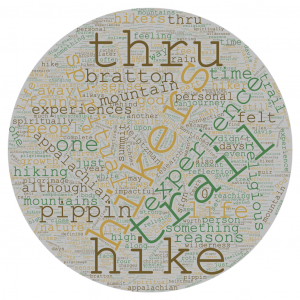
The Appalachian Trail meanders 2,190 miles through the forest between Springer Mountain, Georgia and Mount Katahdin, Maine. Of the more than one-thousand hikers that attempt to walk the entirety of the trail in one year, known as thru hikers, only about a quarter will complete their trek. Despite the grim odds of success, every person that attempts a thru hike—whether they finish or not— comes away from the experience changed. Time in the wilderness, particularly on long adventures such as a thru hike, is spiritually impactful and life changing. The changes aren’t always readily apparent, but it is impossible to embark on a thru hike and not walk away a different person. Hikers may view these changes through a religious or spiritual lens, or they might not notice them at all, but regardless, Appalachian Trail thru hikers partake in a spiritually transformative experience during their four- to six- month crusade.
Thru hikers represent a fairly diverse group of people, consisting of many backgrounds, personalities, religious views, beliefs, ages, and habits. Where thru hikers are not as diverse, however, is in terms of race. Each year, thru hiking blog and website The Trek conducts a broad, intense survey of Appalachian Trail (AT) hikers. The results of this survey, although not exactly related to the spiritual dimensions of a thru hike, do paint an informative picture of the typical AT hiker that may lend itself to interpreting the personal, spiritual experiences discussed later underneath a particular lens. The Trek’s 2019 hiker survey had 365 respondents, 70% of which were 2,000-milers.1 Thru hikers represent a majority of respondents because the survey was intended for long-distance hikers. The actual percentage of thru hikers that complete the trail each year hovers near one-quarter. Although hikers in the 20- to 30-year age range were the most populous group, the mean age of respondents was 36, indicating that a sizeable portion of hikers were over the age of 30, with the oldest being 70 years old (Mariposa, 2019). Clearly, age is not an isolating factor. Race, however, was. Of those surveyed, 95% were white, while other represented ethnicities included Hispanic (2%), Asian (1.4%), multiracial (0.8%), and Native American (0.8%) (Mariposa, 2019). Zero hikers surveyed were Black. Racial and ethnic diversity has historically been underrepresented on the Appalachian Trail due to a variety of complex factors which could comprise their own research paper. Most AT hikers are from the United States (90%), although 2019’s hikers hailed from countries such as Australia, Canada, England, Denmark, the Netherlands, El Salvador, France, Germany, Ireland, Mexico, Taiwan, Poland, and more.1 Despite the array of countries, it is worth noting that the demographics of those countries are still mostly white. Susan Bratton’s 2007-8 survey of AT thru hikers analyzed, among other things, their religious views. The results, published in The Spirit of the Appalachian Trail, show that 57% of hikers had continuing, active religious involvement; another 22% had minimal, lingering attachment to organized religion; and 21% had no religious or spiritual engagement (Bratton, 2012). Of those engaged in religion, the majority (57%) were Christian. The remaining representation came from Judaism (4%), Buddhism (6%), other world religions such as Taoism (3%), and another 8% were classified as holding alternative, New-Age religious interests (Bratton, 2012). Regardless of race, age, or religious affiliation, it is likely that an Appalachian Trail thru hike in some way influenced hiker’s thoughts about religion, whether they had pre-existing connections or not, and at the very least resulted in an inner dialogue and reflection that shows spirituality.
I began my own Appalachian Trail thru hike in May 2016, a few days after graduating high school. In continuation of the above section, the perspectives I offer are one of a young, white, Christian American. I chose to hike the AT for a variety of reasons. I hiked to fulfill a four-year dream and to experience the adventure of a lifetime. I wanted to see the mountains, but there was a part of me that wanted to accomplish something noteworthy. I had not held strong self-esteem in high school, and a part of me felt that hiking the AT would prove to people I was worth something, would impress the people that had always impressed me. I thought this accomplishment would help me be “cool.” But I had stronger, more personal reasons for hiking. At 18, I wasn’t sure where I wanted my life to go. I didn’t know what I was passionate about or how to get there. I wasn’t ready for college. I wasn’t sure who I was, and the AT was a chance to leave behind the masks I had worn in high school and become an individual. My Appalachian Trail thru hike was an exploration—of the eastern US, of myself, and, without intending it, of my spirituality.

I wasn’t a person of strong faith when I set out on my thru hike, although I did identify as Christian. However, the AT made it difficult not to believe in something bigger than myself. The impressive views, star-filled skies, genuine community, kindness of strangers, and difficult climbs left me feeling humbled and selfless. With ample time for reflection, I found an awakened sense of spirituality on the trail. I often felt a part of something greater and looked out over the sublime views of the White Mountains knowing that there was a god out there that created the majesty I beheld and provided me with the opportunity to experience it. Even just seeing the kindness of strangers—trail angels—that offered rides, meals, a bed, or simply words of encouragement gave me a profound feeling of hope.
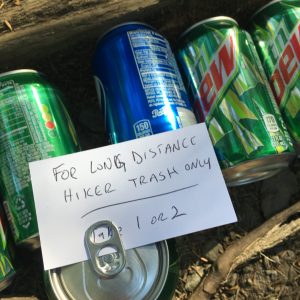
I can’t honestly say that I felt God’s presence each of my 139 days on the trail, but I did feel a sense of spirituality in every mile that only time in nature can provide. Still, there were a few experiences that gave me the unequivocal sense that God was real. One such experience occurred as I climbed Sinking Creek Mountain in southern Virginia. I had just suffered through a week of loneliness and steady rain. My spirits were low, and my gear was soaked. That afternoon, though, had been sunny and held promise of better days to come. Soon after reaching the top of Sinking Creek Mountain, a strong thunderstorm suddenly blew in, high winds and sideways rain stinging my face. There was nowhere to escape the storm, so I just hiked on. As my boots became soaked once again and I bent over to shield my face, I grew frustrated with things that were out of my control. Thunder bellowed nearby and I slipped in the mud on the high ridgeline. I was fed up with the rain, the trail, and the weather. I stopped, lifted my arms in the air, and screamed. I shouted and cursed at the top of my lungs. I didn’t care who heard me. The rain drowned out the noise. I cursed at the trail and at God, at anybody that might listen. I slammed my trekking poles into the muddy ground in front of me. I needed to release my frustration, express my anger someway. As I finished my tirade, a loud clap of thunder sounded and lightning struck a tree alarmingly close, so close I could smell burnt wood and hear the tree splintering. I took it as a sign that I shouldn’t be so ungrateful. I hurried on in silence, accepting the rain and its burden of misery.
I realized I had no reason to be angry at the trail or God or anyone. Thunderstorms are natural and, as the saying goes, “No rain, no pain, no Maine.” I also realized that perhaps a ridgetop was not the safest place to be in a thunderstorm, so I hiked quickly across slick rock and slippery mud until the trail turned downhill and the danger passed. There was no way to escape the storm, nothing to do but hike in silence, let the rain soak my clothes, and pray that lightning didn’t strike me. One of my most spiritual moments on the trail didn’t occur in an incredible experience, but rather a harsh, perhaps unpleasant reminder that God was there.
Some thru hikers embark on their journey with the goal of spiritual renewal. Jason Horstman, a 2016 thru hiker that I met during the final month of my own thru hike, was one such person. It is worth noting the story behind Horstman’s trail name, Pippin, as this speaks to his reason for thru hiking and desire for a spiritual experience. As a fan of The Lord of the Rings trilogy, the name originates from one of J.R.R. Tolkien’s characters. The hobbit known as Pippin is truly named Peregrin Took. This name, Peregrin, is a derivative of the word peregrine, which is defined as the tendency to wander. Put simply, peregrine is another term for pilgrim, a person that embarks on a journey to a sacred place (a pilgrimage) for religious or spiritual reasons. Adventurers that set out to hike the Camino de Santiago, a long-distance pilgrimage in France and Spain, are often referred to as “los peregrinos.” Thus, this convoluted history of fictional characters and word origins is precisely why Pippin chose to call himself that—because he saw himself as being on a pilgrimage when he was hiking the AT.
Pippin began his thru hike after graduating college, on the heels of a senior thesis that explored the relationship between Roman Catholic and Buddhist monasticism. In the research for his thesis, he had a highly spiritual experience at the Gethsemani monastery in Kentucky, made popular by Thomas Merton, that caused him to nearly convert to Catholicism. The solitary experience of the monks there partially sparked his interest in pursuing a thru hike as a spiritual experience. Now a student at St. John’s University in Minnesota pursuing a master’s in theology (with a specialization in monasticism and spirituality), Pippin spoke to me of early-Christian martyrdom. With the rise of Christianity, martyrdom, long seen as the pinnacle of living out one’s faith, gave way to other devout expression. One such expression is what Pippin referred to as “green martyrdom,” in which one pursues a simple life away from society where wilderness is a means to encounter God. At the start of his hike, Pippin saw himself as one such green martyr. Seeking more than a Lord of the Rings fantasy adventure, Pippin set out on the AT because he felt called to it. Given the impetus behind his hike, it is no surprise that Pippin’s hike was sprinkled with spiritual experiences. In an interview with me, he mentioned that a thru hike is not a spiritual experience like meditation, poetry readings, or a commune with nature; it sucks at times. Two spiritual experiences stood out to him, one during an emotional high and another during a low. For the first, Pippin was nearing the summit of Mt. Moosilauke, the first mountain above the timber line that northbound hikers climb and the first peak in the White Mountains. Moosilauke’s intimidating elevation profile and 2.5-mile-long climb did not deter Pippin from reaching the summit, where he basked in a crisp wind and the scent of evergreens. He felt pride upon reaching the summit, was impressed with creation, perceived an intense connection, and felt a part of the world and everything in it. Earlier in his hike, he had felt immense loneliness when a close friend left him, much as I had. But this loneliness brought about spirituality and made the communal experiences that much more powerful. In the midst of his sorrow, he had a close encounter with a female black bear and cub and an incredible thunderstorm. These experiences gave him the realization of not being in control, an acceptance of his fate, and an encounter with his own mortality.
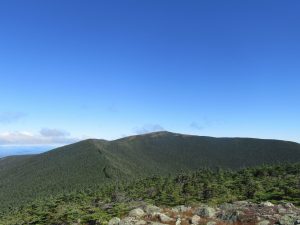
Pippin and I are not the only people that have had a spiritual experience on the AT. Not everyone attributes these experiences to God or a particular religious tradition, but it’s hard to deny that a thru hike is life changing and impactful. Pippin referred to this sense of spirituality as inter-religious, as everything that brings meaning to the human experience. These inner changes to the self, to the way a hiker thinks, acts, or sees themselves, are the result of the AT’s spiritual influence. A lot of what hikers get out of the trail spiritually comes from what they put in—the why. Zach Davis, a former AT thru hiker, wrote a book called Appalachian Trials which focused on helping prospective thru hikers mentally prepare for the journey. In it, he suggested that hikers make a few lists, including one of reasons why they want to thru hike and another of how a thru hike will change them (Davis, 2012). The benefit of these lists is twofold. For one, fleshing out the “why” behind their hikes can help people determine if a thru hike is what they really want to do. Secondly, Davis suggests hikers keep a copy of these lists to reflect on throughout the hike (Davis, 2012). Invariably, every thru hiker experiences bad days when they want to quit. When those days happen, hikers can look back at that list of reasons why they are there and why the hike is important. I venture to say that for most people, hiking the AT to prove something to someone else or gain recognition for a feat are not sufficient reasons for hiking. When the worst days happen, those reasons are not enough to keep someone on the trail. Often, the difference between the hikers that drop out after a week or two and those that trek the entire trail comes down to mental fortitude. That is, the spiritual, personal reasons why they are out there. Hikers that are on the trail for deeply personal reasons, hoping to discover something about themselves or gain a greater understanding of something, are the ones that finish.
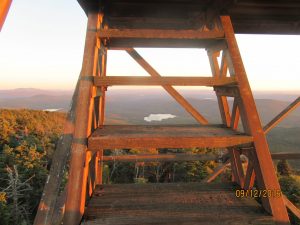
For those with the mental fortitude, the time for reflection on the trail is deeply rewarding. Julianne Roth, a 2015 thru hiker, spoke of the overwhelming belief that a thru hike is a primarily physical feat when, in reality, the mental aspect is so much bigger (Roth, 2016). Roth enjoyed the “constant meditation” on the trail and the ability to “just be with your thoughts.” Reflecting on the spiritual connection between mind, body, and nature that she felt on the hike, she said, “I have never felt more connected with myself and nature…The trail taught me to love myself, again” (Roth, 2016). Paul Heintzman explored the relationship between outdoor recreation and spirituality, although not specific to thru hiking. Heintzman’s research showed a link between the motives behind nature recreation and the spiritual experience that results from it (Heintzman, 2009). Thus, the reason why thru hikers set out on the trail correlates to the spirituality of the experience. If those that are finishing the trail are out there for what Bratton calls personal rather than challenge- or accomplishment- oriented reasons, then they may gain more spiritually from their hike (Bratton, 2012). Bratton found that hikers travelling longer distances along the AT—more than 300 miles—found greater personal growth in their relationships with other people, relief from stress, and beneficial life changes.2 It took hikers two or three weeks to reach this point, so many adventurers setting out on weekend or week-long trips would not fully realize the spiritual implications of time in nature that thru hikers did. Bratton’s AT study could not, however, reach any conclusions about what factors along the AT led to this spiritual awakening, such as being surrounded by the beauty of nature (Bratton, 2012). My own experiences indicate that the surreal beauty of the trail, from jaw-dropping views at the top of a fire tower to the singing of a mountain stream, play a role in the spiritual effects of a thru hike, but aren’t the full picture. Heintzman (2009) explored some of the other factors in the spiritual growth that people feel in the wilderness. Aside from being in the natural world, being away from the stresses, deadlines, and busyness of everyday life was important. Further, the tranquility and calm of the setting were instrumental, as was the challenge of the hiking (Heintzman, 2009). I would agree, as I feel that personal growth often arises from moments of suffering that teach the individual how to push themselves, what they’re capable of, and form a tight connection between mind and body. On my own hike, I hardly felt more alive and present than I did struggling up Maine’s Mahoosuc Arm, more accomplished than I did powering through long days in Virginia, or more content with my life than when I was trudging through the cold wind on top of Baldpate Mountain. One of the final components in achieving spiritual renewal in wilderness settings is from solitude (Heintzman, 2009). Pippin noted that had his hike been more of a group experience than a solitary one, he would not have gained the same spiritual benefits. Indeed, I found that, as incredible as the community formed around shelters and campfires is, I fully enjoyed the time for reflection that nights spent alone in a serene setting, such as at the Hemlocks Shelter in Massachusetts, provided. Famed American environmental author Sigurd F. Olson may have put it best when he quipped, “There is no such thing as killing time, for time is enhanced by the gift of solitude.”

The Appalachian Trail is a terrific vessel for spiritual growth, but is by no means the only method of achieving heightened introspection and reflection. Dozens of long-distance trails weave around the country, offering opportunities for escape. Long-distance walks for spiritual growth have a history longer than that of the AT. Bratton acknowledges that hikers have long sought refuse on the Camino de Santiago de Compostela in Spain, and Buddhists, Hindus, Bons, and Jains have trekked around the perimeter of sacred Mount Kailas in China, although the summit itself was too sacred to climb (Bratton, 2012). Pilgrimages are a millennia-old hobby, and don’t seem to be going away anytime soon. While some hikers take to the oldest mountain range in North America for renewal along the AT, others head to the alpine temples in the Range of Light that John Muir found to be spiritually empowering and worth fighting for. Muir’s name is bestowed upon a 210-mile footpath through the Sierra Nevada Mountains. Fittingly, just as Muir found a sense of the divine among California’s highest peaks, thru hikers of the John Muir Trail find similar personal growth. The authors of a research paper that analyzed the link between John Muir Trail (JMT) thru hikers and spirituality saw the importance of these hikes, saying, “Journeys to and within these natural areas, even when conducted with non-religious motivations, resemble religious pilgrimages in that they are transformative experiences undertaken by individuals or groups for the purposes of spiritual or emotional benefit” (Hitchner et al., 2018). The study looked at the blogs of JMT hikers and found that most, but not all, had experienced a profound or impactful time on the trail (Hitchner et al., 2018). Hikers mentioned ideas such as renewal, awareness, escape, and worship, while a few even directly considered their journey to be a pilgrimage (Hitchner et al., 2018). Although the JMT took hikers only three weeks to complete, many thru hikers emerged with similar sentiments as the AT thru hikers that Bratton studied.
Four years after my thru hike, I still feel the spiritual impacts of it. Hikes like that truly are life changing, not just in the moment but long-term. As Bratton found in her research, the community on the AT is one of the influential factors. I went on the AT hoping to get away from people and have a wilderness experience, but when I left the community had become the best part of the trail. The friends, like Pippin, that I met along the way, although scattered across the country, remain some of my closest friends. In my search for meaning along the AT, I discovered what I was passionate about. I learned that my passion lies in nature and I came away determined to protect the mountains I had come to love. In a way, the AT molded who I am as a person, all the way down to the major I pursued in college. Bratton found a similar link between thru hikers and environmental concern, something not at all surprising given that the oneness with nature experienced on the trail leaves you feeling as if every person deserves the opportunity to experience the same thing.2 I also learned on the AT the healing power of time in the woods, of the internal growth that comes from suffering, of the need in my own life to spend time in the mountains to reset my body and soul. The AT taught me that when I am stressed, overwhelmed, confused, afraid, or lost in my life, I can find healing and clarity in the mountains. That’s a lesson I won’t soon forget. While four-month pilgrimages aren’t always feasible, I can still find temporary restoration in a weekend or week-long excursion. I also came away from the trail feeling a closer connection to God than I ever had before. I knew unequivocally that there is a God, and I see that most evidently in the woods and mountains. Bratton (2012) found that relatively few of the hikers she surveyed were actively involved in their religion or attended services regularly. I’ve attended church much less since I’ve returned from the trail than I did before I started hiking, but I still feel stronger in my faith as a result of the trail. I came to realize that for me, I see God most readily not in a congregation gathered in worship but in the solitude and serenity of a mountain sunset. Bratton (2012) also noted that many thru hikers found the mountains to be their place of worship, just as the JMT study (Hitchner et al., 2018) found that the High Sierras were a temple to many of its visitors. The AT also impacted many other aspects of my life. I came to see what and who I valued in my life, I learned responsibility and independence, I gained confidence in myself, stopped caring how other people perceived me, and started living my life with more purpose. Not all of those effects are distinctly religious, but I believe they are spiritual. Any aspect of inner or emotional change that the AT elicited in me is a spiritual impact, and part of why I believe it is nearly impossible to complete a thru hike and not walk away changed. Pippin mentioned that even four years later the AT was a defining moment in his life, serving as synthesis between his values and his studies and the building blocks of who he is. I mentioned early on in the paper that one of my reasons for beginning the hike was a desire to impress people with a physical feat. Admittedly, that’s a weak reason for embarking on a thru hike. But I didn’t walk away from the trail with any sense of physical accomplishment or feeling like I had done something impressive. What the AT did instill in me was a sense of humility. I had walked 2,000 miles, but so had all the people that surrounded me. All I had really accomplished was pursuing and fulfilling a dream, and it doesn’t take a thru hike to do that.
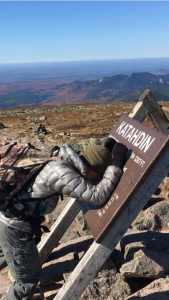
When I climbed Mt. Katahdin on October 11, 2016, I pressed my face against the weathered sign that marks the highest point in Maine and the end of the most challenging, impactful experience of my life. Without shame, tears flowed freely down my face, uncontrollably. Tears of joy and sadness, elation at having completed what I set out to do but sorrow in knowing that all the wonderful memories of the past four months were over. The tears that fell on the rocky summit of Katahdin are a symbol of the spiritual significance of that journey on my life. The fact that even the most hardened thru hikers are flooded with emotion upon touching that sign is proof that a thru hike is a defining spiritual moment in their lives, too. A year later, I came back and climbed Katahdin a second time, as a day hike rather than the culmination of 2,190 miles of self-exploration. Still, even a year later, touching the weathered sign sent a stream of tears down my cheeks. Feeling those same emotions a year after the hike shows just how impactful this trail had been on my life, and the lives of every hiker that trudges up and down its endless ridges. I was connected to the AT; I loved that trail. In the triumphal moment I draped my body across the magical sign that had inspired me for months, I didn’t need researchers like Susan Bratton, Paul Heintzman, or those that studied JMT hikers to tell me that a thru hike is a spiritually defining moment. I knew it in my heart, and always will.
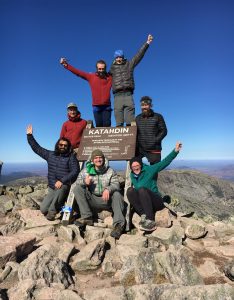
References
Bratton, S. (2012). The spirit of the Appalachian Trail: community, environment, and belief on a long-distance hiking path. University of Tennessee Press.
Davis, Z. (2012). Appalachian trials. Zach Davis.
Heintzman, P. (2009). Nature based recreation and spirituality: a complex relationship. Leisure Sciences, 32(1), 72-89. https://doi.org/10.1080/01490400903430897
Hitchner, S., Schelhas, J., Brosius, J., & Nibbelink, N. (2018). Thru-hiking the John Muir Trail as a pilgrimage: implications for natural resource management. Journal of Ecotourism. https://doi.org/10.1080/14724049.2018.1434184
Mariposa. (December 6, 2019). The 2019 hiker survey: general information. The Trek. Retrieved November 26, 2020 from https://thetrek.co/appalachian-trail/2019-hiker-survey-general-information/
Roth, J. (2016). Spirituality and the trail. The Trek. Retrieved Nov. 5, 2020 from https://thetrek.co/spirituality-and-the-trail/
